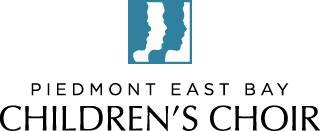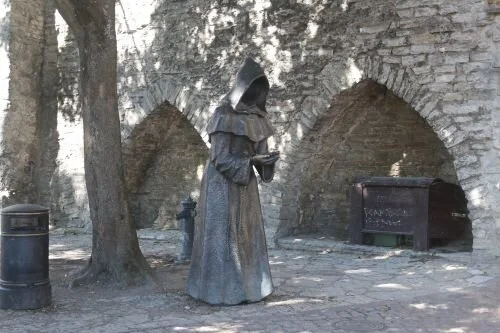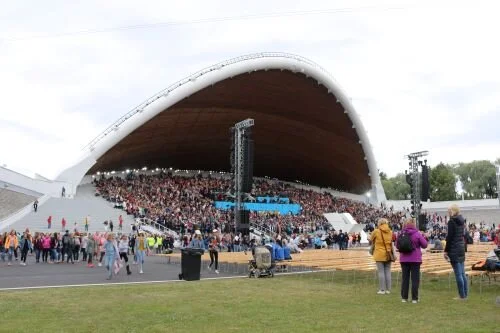Day 11 - Tour of Tallinn and Rehearsal
July 5, 2019 | EnsTour Blogger
This morning, our hosts arranged a walking tour for us through the picturesque Old Town of Tallinn, which is the best-preserved medieval city center in northern Europe. We began in the Upper Town, formerly reserved for the nobility and aristocracy, perched on top of the hill of Toompea. After marching up on the steep and windy cobblestone streets, our group gathered in front of the Estonian parliament building, a neoclassical structure erected next to the surviving parts of a medieval castle. We admired the Estonian flag perched atop the castle tower, which marks the traditional seat of power in the country, and heard about Estonia’s form of parliamentary democracy, in which the president is largely a symbolic figurehead who avoids any form of party association.
We then headed into the Russian Orthodox cathedral across the street, with its characteristic onion domes soaring up into the clear blue sky. The students listened with great interest to the service going on at a side altar, as the space rang with the resonant sounds of a trio of singers chanting in Church Slavonic. We learned that Estonia is one of the most secular countries in the world, with only 25% of the population attending a religious service at least once a year.
As we walked through the winding alleyways, which follow the original 13th-century city plan, our guide told us about the Estonian social welfare system. The singers gasped when they found out that all education is free through your first bachelor’s and master’s degree. Moreover, to encourage career mobility, that promise is renewed every ten years so that you can always return to school in a new discipline. Outside of college, vocational school (still free) is highly prized here, with the top two trades being hairdressing and auto repair. All this is paid for by a 55% overall tax rate that is done by your employer - according to our guide, tax day takes less than five minutes for ordinary people.
After some shopping and a pause at some of the vantage points, which gave beautiful views of the Baltic Sea and surrounding city, we descended towards the massive medieval city wall, which separates the Upper Town (for the nobility) from the Lower Town (for the merchants). Passing through the gate, we arrived in the town square in front of the Tallinn town hall. The kids scattered to enjoy the marzipan museum, a look at the oldest continuously functioning apothecary in the world, or to do some shopping at the many handicrafts and art stalls surrounding the area.
We enjoyed lunch at a delicious make-your-own pizza and pasta place, which was a big hit for all, before walking through the modern city to observe the final rehearsal for the Tantspidu, the massive dance festival that occurs concurrently with the Laulupidu. This takes place at a massive sports stadium, with up to 10,000 dancers in traditional Estonian costume on the field taking part in extraordinary choreographed dances. We were entranced by the coordination and grace of the dancers, who swept in and out of complex and beautiful patterns spanning the entire length of the field. After watching the first seven dances, ranging from the “Sunrise Chant” with 912 women to “Birds on the Coast” with 1440 dancers from various family groups, we headed out of the stadium to make it to the Song Festival Grounds (Lauluväljak) in time for our first rehearsal.
The Song Festival Grounds were just as enormous as we had imagined from viewing the documentary “The Singing Revolution” back at choir camp last August. The massive “Singing Arch” rose proudly from the grounds, with a vast expanse of green lawn sloping gently upwards behind it. Etched out from the middle of the risers was a platform for the orchestra, and in front stood a two-story high platform for the conductor and vocal soloists. Today’s rehearsal was for the select choirs from the different choral groupings, so we participated in the select children’s choir and select massed choir rehearsals. Before each one, the singers lined up around the perimeter of the grounds looking for the signs indicating “Valiklastekoor I, II, or III” (select children’s choir soprano, mezzo, or alto). Then, they marched under the arch and found their spots on the vast risers for rehearsal. The sound of the massed children’s choir, around 1500 singers, was glorious as they launched into a new piece by the famed Estonian composer Arvo Pärt. Although we couldn’t understand the language of the rehearsal, the conductor made it clear what he wanted through his gestures and singing demonstrations.
After our first rehearsal, we headed to a converted industrial warehouse on the grounds to line up for dinner. This was an efficient operation, with ten lines of servers pourings bowls of soup and providing loaves of bread. We headed out to the lawn outside where we received barley ice cream from a truck of Estonian soldiers, whom we serenaded with “Mariposa candorosa.” Then, it was back on stage for the second rehearsal with the select massed choir of around 6500 singers. The singers flowed up the risers once more to join together in a piece inspired by the traditional Estonian regilaul, a chant which alternates between soloist, choir, and in this case, audience. Two others pieces offered a cheerful and upbeat conclusion to the evening. It was truly breathtaking to be here, standing amidst thousands of singers in Estonian traditional costume celebrating their culture and freedom, and it finally hit home what an honor it is to participate in this celebration. The singers came away awed by the experience, and determined to make sure that all of the months of learning the music and working hard on their Estonian pronunciation paid off as they joined together in song.











































